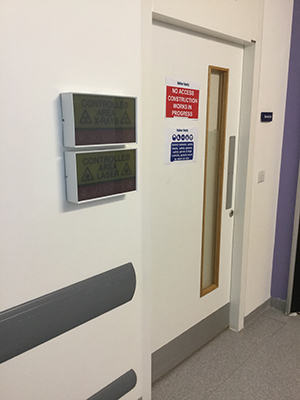Medical Air Technology (MAT) has completed work on a major seven-theatre upgrade project at Queen Elizabeth Hospital in Birmingham, the largest single site hospital in the country and one of the highest performing NHS organisations. Operated by University Hospitals Birmingham NHS Foundation Trust, patient numbers have increased considerably since the popular hospital opened in 2010, necessitating theatre upgrades to increase surgical capacity. Queen Elizabeth Hospital also hosts The Royal Centre for Defence Medicine (RCDM), the primary receiving unit for all military patients injured overseas.
Over a ten-month period on site, MAT carried out a substantial programme of work to existing facilities to increase the range of surgery available. Of the five theatres upgraded to ultraclean with the addition of MAT’s unique ECO-flow ultraclean ventilation (UCV) canopy, four were also “laser-proofed”, as were two further general theatres, making them suitable for laser surgery. In laser surgery, surgeons use an intense narrow beam of light to cut, rather than a scalpel. This allows them to work at high levels of precision by focusing on a small area, damaging less of the surrounding tissue. Laser-proofing the theatres necessitated the addition of LASER IN USE signs, laser-proof door blinds, laser-proof baffles, electric blinds, door interlocks, and laser command sockets. A final general theatre completed the seven-theatre upgrade.

The various different elements contained within this project meant many sub-contractors were involved, up to 24 per theatre. Scheduling this number of people, all working in a live environment next to theatres operating day and night, with multiple areas being worked on at one time, was a demanding programme. Weekend and night works were also required to ensure deadlines were met. However, close liaison between all involved meant disruption was kept to an absolute minimum during the build, and MAT was very proud that there were absolutely no complaints from clinical teams in the live theatres about noise, dust or general disturbance.
Two particular challenges arose during the project, both calling for innovative responses from MAT:
- In order to access theatres at the end of the corridor on the ground floor, a long temporary covered weatherproof walkway was erected over a grassed area at the end of the recovery ward, creating an alternative route for contractors and equipment.
- Access to theatres on the second floor was restricted – to overcome this, MAT erected an external scaffold and temporarily removed highly specialised and expensive external glazed curtain wall cladding panels to install a weatherproof access route.
This complex and substantial project was completed on time, and within budget – a testament to the success that can be achieved when all parties involved are absolutely committed to working together to deliver the best solution.





